
Background information
Samsung’s TV head honcho: «We don’t need Dolby Vision for a good picture»
by Luca Fontana

OLED or LCD? The Samsung S95D blurs the boundaries. With its innovative anti-reflective coating, it combines the best of both worlds – vivid colours and perfect black, even in bright rooms.
Full Disclosure – the TV, the 65-inch version of the S95D, was provided to me by Samsung for testing.
When OLED manufacturers such as LG, Sony or Samsung announce their new flagship models, they usually advertise revolutionary panels, more powerful processors and the resulting unprecedented peak brightness. This is because OLED television technology doesn’t produce as bright results as their LCD competitors, making them particularly inferior during the day. When TVs aren’t bright enough, reflections on the dark screen make it difficult for you to see anything.
Samsung’s taking a different approach this year. And it’s equally simple as it is genius: a brand new anti-reflective coating is designed to prevent the TV from competing with the brightness in a room and instead simply absorb the ambient light and, well, send it to hell.
It makes me smile. Because it’s precisely this simplicity, beyond the usual superlatives and marketing buzzwords, that contains an incredible amount of elegance – and is a real game changer.
Samsung remains true to its modern and slim design with narrow edges and no frills. And so they should. I’ve always liked the Infinity One design, Samsung’s trademark. The TV is held together by an elegant aluminium frame at the front and a black plastic cover plate at the back. Plus a curved, wafer-thin base. It may not be very noticeable, but it measures a full 27 centimetres in depth. Depending on your TV furniture, space for a soundbar in front of the TV may be limited.
But Samsung does leave a bit more space between the lower edge of the panel and the TV cabinet, seven centimetres in fact. That should be enough for most soundbars. Note that if you cover the infrared sensor for remote control, switching the TV on and off becomes a real pain.
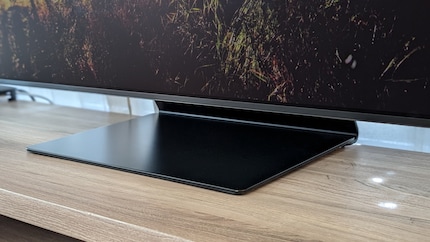
The complete package also includes the One Connect Box, which is standard on Samsung’s top models. In other words, it’s a small box that replaces the connectors usually built into the panel. There’s just a single, fairly inconspicuous cable that connects the One Connect box to the TV and provides power to the screen. This gives you the option of elegantly concealing the box and all the tangled cables in a drawer of your TV furniture.
Looking at it from the side, Samsung’s S95D is just as thin as its predecessor – one centimetre according to my measurements. And thanks to the One-Connect-Box, which externalises some hardware components such as the processor and motherboard, the panel doesn’t get any thicker further down. This makes it easy to mount the TV on a wall – but you’ll need a VESA 400×300 mm mount, which isn’t included. You can find them in the shop here.
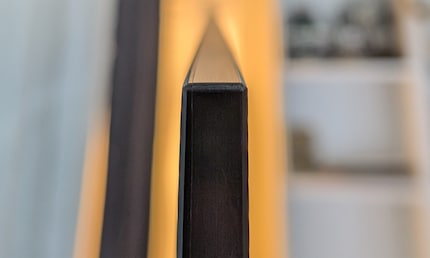
Now for the specs. Sony’s S95D offers the following:
All four HDMI inputs support HLG, HDR10 and HDR10+. Dolby Vision, on the other hand, is still absent. Unfortunately. And it’s unlikely it’ll change in the future. It was only at the beginning of the year that Nathan Sheffield, Samsung’s then Head of TV and Audio Europe, told me in an interview: «I’m not sure what Dolby Vision would do for Samsung that we can’t already do anyway.»
The S95D can handle Dolby Atmos, including passthrough if you want to forward the sound to an external sound system. DTS audio formats, on the other hand, are neither supported by the built-in speakers nor passed through by the TV. Instead, they’re reproduced and passed on as lower-quality multichannel PCM 5.1 audio.
*The following is a deep dive into the subject matter. The measurements I’ve taken were with professional tools from Portrait Display, to get an objective classification of the image quality. If you’re not interested in details and diagrams, you can read the short version and then scroll to «The picture: realistic colour reproduction with slight weaknesses».
Here’s a summary of the key stats:
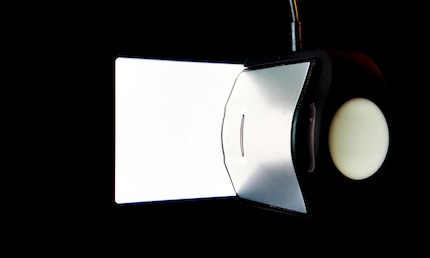
About the measurements. I measured all of the TV’s screen modes without calibrating it i.e. just as it came out of the box. I’ve only made a few changes to the settings:
As in the previous year, Filmmaker mode achieved the best measured values for all types of content. Except when gaming, which you should always use gaming mode for due to the input lag.
Now, let’s take a look at the brightness of the S95D. In the chart below, I compare it to its big competition, LG’s G4, its direct predecessor, the S95C, and Sony’s QD OLED model from last year, the A95L.
What can I say? Samsung’s OLED flagship this year – QD OLED flagship to be precise, takes the top spot. (For some reason Samsung doesn’t like to talk about QD OLED.)
Samsung’s S95D achieves an excellent 1627 nit peak brightness at a window size of ten per cent. In other words, around 200 nit brighter than any other top OLED TV I’ve ever tested. This might mean a bit more to you: a few years ago, figures like these were considered a crazy fantasy, at least for OLEDs.
Samsung’s S95D doesn’t hold back when it comes to brightness in the 100 per cent window either – that is, an image section as large as the entire display itself. With 292 nits, it also outshines its OLED competition, albeit «only» by around 40 nits. You can just about see the difference when you put the S95D and LG’s G4 right next to each other. But you’d have to look very closely. Nevertheless, one nil to Samsung.
Let’s take a look at how well Samsung’s flagship this year reproduces white, colours and shades of grey. Something I’d like to answer in three questions:
Each pixel in the Samsung S95D consists of a red, green and blue sub-pixel. White is created when they all radiate at the same time and with the same intensity. In other words, full brightness generates the brightest white. The lowest brightness, on the other hand, creates the darkest white. Or to be precise, black, or true black for OLEDs. In between are shades of grey, of varying brightness. This is what’s meant when we use the term greyscale measurement.
The greater the difference between the brightest and darkest pixels, the better the contrast values. However, I won’t bother measuring the contrast, because like all OLEDs, Samsung’s S95D can completely switch off individual pixels. This means that the contrast ratio tends towards infinity.
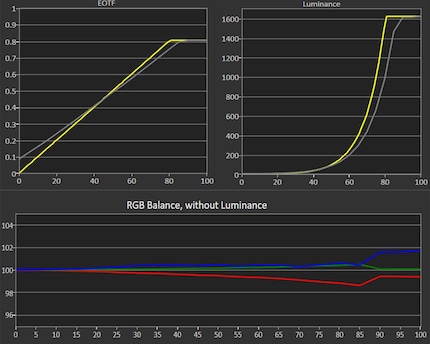
The greyscale measurement on Samsung’s S95 is very good. Grey tones deviate only slightly from the target value. I measure an average DeltaE of 1.8 – even if the blue component is slightly too high and the red component slightly too low in lighter shades of grey. However, the deviation is hardly visible to the untrained eye. For comparison, LG’s G4 achieved a DeltaE of 1.1 in my greyscale measurement.
My measurements for the coverage of the colour spaces:
The S95D achieves an excellent 99.95 per cent coverage in the important DCI-P3 colour space. This is even more than the 96.58 per cent coverage achieved by LG’s G4. In practice, however, this makes no visible difference.
In contrast, Samsung’s QD OLED flagship performs very well with 89.77 per cent coverage of the very large BT.2020 colour space. OLED televisions such as LG’s G4, for example, only achieve 71.64 per cent. This is due to technology. Currently, only QD OLED televisions achieve around 90 per cent coverage of the BT.2020 colour space. This is exactly why the movie and TV industries calibrate their HDR content almost exclusively in the much more widely used DCI-P3 colour space. The BT.2020 coverage is therefore more of an indicator of how well suited the television is for the future.
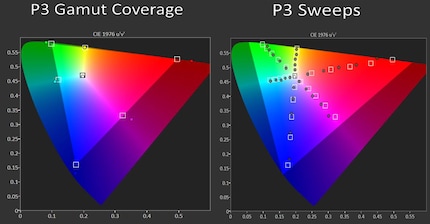
Now for the third and final question: colour fidelity. This describes how accurately colours are represented. As with greyscale, the deviation from the television to the reference value is referred to as DeltaE. The white boxes show the reference colours sent to the TV by the test pattern generator, the black circles show the colours actually measured.
With a DeltaE of 2.18, Samsung also achieves a better value here than LG’s G4 with 2.95. Remember, Samsung doesn’t support Dolby Vision, LG does. Out of the box, i.e. without calibration, Samsung has greater colour fidelity in Filmmaker mode than LG’s G4 in Dolby Vision mode. At least, the figures say so. How it looks in practice is still to come. However, I’d like to say that both models remain below the targeted DeltaE value of 3 – and that the difference is hardly visible to the naked eye, not even to experts.
Reflections on the screen can’t be measured per se. Still, it’s important to address them in tests. For the first comparison, I’m including a picture from my test of Sony’s Bravia 9, a mini LED TV. The photos were taken around midday and without any attempt to darken the room.
This isn’t a mistake. The picture on the left is actually the switched-off display of the Samsung S95D, photographed in exactly the same way. Reflections? Shadows? Zilch. And it’s really bright in my living room. You can see this on the Sony Bravia 9 on the right, where it isn’t just an orange room lamp that’s really visible, but even the photographer (me) and the entire flat! Plus some unsightly rainbow streaks.
Sure, with the screen switched on, even Sony’s Bravia 9 with its peak brightness of over 3000 nit is bright enough to conceal streaks and reflections even in dark scenes. But they’re not completely gone. Samsung’s S95D with «only» 1627 nit peak brightness manages, on the other hand. This is evident in the beginning of Blade Runner 2049:
Can you see why I spoke of «incredible elegance» and a «real game changer» at the beginning? In any case, I’m flabbergasted. All the more so thanks to this comparison. I’ve been saying for years that LCD televisions are better suited to bright rooms than OLED televisions because they’re brighter. And then Samsung comes along, slaps a new anti-reflective coating on its display and changes all the applicable rules.
«Well, well, well. How the turntables…»
One more thing! Yes, not only the reflections in the picture become more matt and therefore much less obtrusive, but also the display itself. This could be something buyers disapprove of because the glossy look, a trademark of OLED displays, is lost. My concerns that this could also make the colours appear significantly less vibrant and rich in contrast have not come true. And even if they did, the fact that I can also watch something at midday, even the darkest scenes, is much more important to me anyway.
So, the picture is very bright for an OLED TV and offers good colour fidelity from the get-go. Theoretically. But how are things in practice?
Let’s move on to a direct comparison with LG’s current flagship, the OLED G4, and Sony’s top model this year, the Bravia 9 – that way we also have a comparison with a different display technology. According to Sony, the Bravia 9 is intended to compete with all top TVs and not just with other LCD televisions.
If you’re interested in my tests of the other two televisions, you can find them here:
To put the colour accuracy of a TV to the test, I like to put on Guardians of the Galaxy, Vol. 2. One particular scene is perfect for this – the TV has to show the fine details of Drax’s tattoos without overexposure, have a certain image dynamic and let Ego’s palace shine in a rich sunset glow. The Samsung S95D captures the kitschy «Golden Hour» atmosphere of the planet intended by the director very well.
Compared to LG’s G4 and Sony’s Bravia 9, however, I find the Samsung picture a tad too bland. As if the «punch» is missing. I prefer the warm, reddish skin tones of LG and Sony, even if Sony’s picture has a slightly too strong yellow-greenish tint for my taste.
Source: Disney+, Guardians of the Galaxy, Vol. 2. Timestamp: 00:56:47.
To provide some variety, I’ve included a scene from Avatar: The Way of Water, starting at minute 00:22, where green and especially blue tones dominate. Especially with the bluish skin tone of the nature-loving Na’vi, I quickly notice that LG’s TV has a much better colour fidelity. What’s interesting is, both Samsung and Sony display the skin colour of the Na'vi slightly greyer than LG. It looks more realistic.
Source: Disney+, Avatar: The Way of Water. Timestamp: 00:48:10.
I see it similarly in James Bond – Skyfall, when James and Q turn their gaze to a painting in a museum that wasn’t chosen at random – a majestic, ageing warship being scrapped. A subtle reference to Bond’s own situation.
Here, Samsung’s S95D produces a more natural picture than LG’s G4 and Sony’s Bravia 9. I pay particular attention to the skin tones. LG and Sony are almost a little oversaturated in this respect, even if I personally still prefer the warm colours. It’s a question of taste, I reckon.
Source: Apple TV+, James Bond – Skyfall. Timestamp: 00:39:02.
How does Samsung’s QD-OLED-TV perform in dark scenes? For this test, the first scene from Blade Runner 2049 comes into play.
Something interesting happens here: Samsung’s S95D has a slight green-bluish tint in brighter areas of the picture, for example near the window. LG’s G4, on the other hand, has a red tint. Both of which were already indicated by the measurements above (see «White balance»). In dark areas of the image, it’s LG that has a slight green tint. Samsung’s S95D is quite balanced in this respect.
Apart from that, however, both televisions produce a wonderfully dark picture. If you’re watching movies against the light, the effect is that everything else turns into black silhouettes. I like that. Surprisingly for me, however, Samsung’s S95D swallows up more details, although in theory it could shine brighter. Sony’s Bravia 9, on the other hand, reveals the most details in dark scenes, as expected. No wonder it’s this bright, as the LCD TV shines thanks to the mini LED backlight.
Source: UHD Blu-ray, Blade Runner 2049. Timestamp: 00:04:50.
Now for a final picture test – detail rendering in bright picture areas. Pay attention to the sun in the background in the following Jurassic World example on the Samsung S95D. Even in such a bright image area, the gradations of the orange tones in the sky remain fine enough to clearly recognise the sun as a sphere. You can’t see any visible white rings around the sun.
Source: UHD Blu-ray, Jurassic World. Timestamp: 00:21:18.
LG’s G4 and Sony’s Bravia 9 give it their all in this discipline too. But for the LG TV, I had to set the smooth gradation for HDR content to medium.
The processor is the TV’s brain. Its main task is to receive, process and then display image signals. The processor recognises poor picture quality and enhances it by removing noise, enhancing colours, smoothing edges, making movements smoother and adding missing pixel information.
Once again, I opted for one of Samsung’s demanding judder tests. Juddering, jerking or stuttering when camera movements are slow is a common problem that all TVs have. One film perfect for observing this in is 1917 by Sam Mendes with his long, steady tracking shots. Pay particular attention to the vertical bars in the barn – do they run smoothly through the picture or do they show a slight stutter?
Source: UHD Blu-ray, 1917. Timestamp: 00:42:25.
LG is still showing what it’s made of. Thanks to its new Alpha 11 processor, there’s hardly any juddering. Samsung and Sony aren’t far behind either. That’s also down to the fact I adjusted the default settings under «Picture Clarity». I set Judder Reduction to «Minimum» and Blur Reduction to «10». Last year, I didn’t change anything on the predecessor, the S95C. This is what it looked like:
Source: UHD Blu-ray, 1917. Timestamp: 00:42:25.
You can tell why I had to change the settings. However, I was told by Samsung that a lot of work has also been done on the Neural Quantum Processor.
Let’s skip to the next scene from 1917. Again, Mendes’ camerawork constitutes an immense challenge for most processors. Hard edges in front of a blurred background – like the helmets of the two soldiers below – present a particular challenge. Both the processor and pixels have to react incredibly fast.
Source: UHD Blu-ray, 1917. Timestamp: 00:35:36.
Here, Samsung’s new Neural Quantum Processor also keeps up well with LG’s Alpha 11. It’s hard to find any differences in the depiction of the heavy flowing camera movement with the naked eye. Incidentally, this compliment also applies to Sony’s Bravia 9 with its XR Master Drive Processor.
Next up on the screen is the Apple original For All Mankind. Here I want to test how long it takes for a single pixel to change colour. If this isn’t done quickly enough, it’ll appear as if the image is blurred – this effect is known as «ghosting». Take a look at the text that appears at the bottom left when the camera pans across the lunar landscape.
Source: Apple TV+, For All Mankind, Season 1, Episode 5. Timestamp: 00:00:10.
Problems? None. With Samsung, LG and Sony, the displayed texts always remain razor-sharp. But that’s not always the case. To demonstrate what I mean, I’ve added a comparison with TCL’s C82 model at the end of the video. To be fair, I should mention that this device is also two years older. So you can’t make a direct comparison, especially as TCL has already made significant improvements in successor models.
Now for the most demanding test. I want to find out how well the processor can enhance low-quality sources, be it Blu-rays, live TV or The Walking Dead. This series was intentionally shot on 16 mm film to convey a damaged, post-apocalyptic atmosphere through the old film grain and image noise.
Source: Netflix, The Walking Dead, Season 7, Episode 1. Timestamp: 00:02:30.
Take a close look at the dark area between the two mortal enemies. In the first comparison, LG is on the right and there’s almost no image noise. Almost no compression artefacts. Basically, the picture is sharp, pleasantly warm and rich, but still natural. With Samsung and Sony, on the other hand, impurities are clearly visible. And this despite the fact that I even tried to reduce the image noise in the Samsung settings.
When measuring the colour accuracy in Game Mode, I get a solid average Delta E of 3.41 (read the section on white balance, colours and grey tones further up if you’re interested in more detail). This is one of the better values I’ve measured in gaming mode on a TV – even slightly better than LG’s G4.
On the subject of input lag, using the measuring device from Leo Bodnar, I measure an average input lag of 10.4 milliseconds with a UHD image at 60 frames per second and HDR activated. This is a really good value and almost on the same level as LG’s G4 which manages 9.8 milliseconds here. Plus, the value is below 20 milliseconds, which a game mode should achieve nowadays.
Apart from that, the TV supports all features relevant for gamers:
In addition, Samsung, like Sony, LG, Philips, TCL and Panasonic, has entered into a partnership with major game studios. As a result of which, the HGiG (HDR Gaming Interest Group) was founded. According to the manufacturer, this’ll ensure HDR is displayed as intended by game developers, for example when I play Spider-Man 2 on my PlayStation 5.
Source: PS5, Spider-Man 2, 120 Hz mode, HDR, VRR and ray tracing enabled.
What Samsung presents here is a visual highlight. With a smooth 120 frames per second, I dash through the urban canyons, defeat enemies in intense battles thanks to minimal input lag and enjoy effortless gliding over New York’s rooftops. Vivid colours, flawless contrasts with rich blacks and a picture that remains razor-sharp even during fast movements is the cherry on the cake for a more than satisfactory gaming mode.
Samsung relies on Tizen, which was completely overhauled in 2021 and is now more reminiscent of Google TV. In other words, pressing the home button opens a whole window full of tiles. From there, you can access your TV apps or various HDMI inputs.
Source: Samsung Tizen.
Other than that, there’s not much left to say. As with Google TV, there are still annoying movie and series recommendations that I never need. Still, navigating in the menu and between apps feels very smooth and responsive – thanks to the good processor. And as always, this year’s TV comes with «Ambient» mode. That’s when it switches to an art mode. I can choose it to display either a clock, a painting or a moving image. The idea being to liven up the TV at low power, low brightness and rid of the rectangular black hole.
Samsung’s S95D is an impressive TV with its innovative anti-reflective layer, redefining the playing field between OLED and LCD TVs. Even in bright rooms, it delivers a razor-sharp picture with rich blacks and radiant colours.
The powerful Neural Quantum Processor ensures smooth movements and very good upscaling, while gaming mode with minimal input lag and 120 Hz support ensures an immersive experience.
Although the measured colour fidelity is excellent, colour reproduction in practice isn’t quite as vivid as that of some competitors. Plus, there’s no Dolby Vision – always a killer criterion for many. Nevertheless, the S95D impresses with its overall performance and is particularly suitable for anyone who values a low-reflection picture in bright rooms.
Pro
Contra
I write about technology as if it were cinema, and about films as if they were real life. Between bits and blockbusters, I’m after stories that move people, not just generate clicks. And yes – sometimes I listen to film scores louder than I probably should.